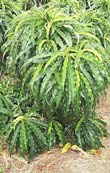
June 2002
The Daley News
Featuring:
What's New
The Nursery
The Orchard
Fruit Tree of the Month
Rainforest, Dryland Native and Hedge Plants
Feature article
What's New - The Bilimbi
 It's a close relative of the carambola but that is rearly where the similarity ends. It is different in appearance, manner of fruiting and its many uses.
It's a close relative of the carambola but that is rearly where the similarity ends. It is different in appearance, manner of fruiting and its many uses.
The mature fruits have a crunchy watery flesh that resemble the texture and appearance of small cucumbers. The 5 - 8cm fruit is crisp when unripe, turns from bright-green to yellowish-green, ivory or nearly white when ripe and falls to the ground. The outer skin is glossy, very thin, soft and tender, and the flesh green, jelly-like, juicy and extremely acid.
The fruit is generally regarded as too acid for eating raw so are used extensively in soups, sauces, curries and sambals.
The recipes specifically using Bilimbi are few and far between however I was able to find a delicious looking vegetarian recipe at this site. http://www.angelfire.com/trek/combuisindo/Categories/vegetable_dishes/sambal_goreng_tempe.htm
The Nursery
Like a lot of areas in Australia we are experiencing a shortage of water. Fortunately we having a national governing nursery body that helps to keep us informed of our water usage responsibilities and way in which we can conserve water.
Irregular water may keep plants alive but it can cause undue stress so its always best to keep up a regular supply. To help you conserve water in your home garden you can follow these basic steps.
6 Habits of a water efficient garden
Plan and prepare your garden, group plants with similar needs (water zones) together; set up wind breaks and create shade areas to minimise water evaporation.
Improve soil structure
Increase organic matter ie. Mulch, peat, compost, manure, and water crystals will increase water holding capacity, moisture retention and plant health
Grow the right selection of plants
Consider: size, shape, function, appearance, water requirements
Natives flourish on minimal water
Reduce grassed or lawn areas by increasing paved areas. Plant more ground covers
 Water less, but more deeply, to increase root development
Water less, but more deeply, to increase root development
Have a licensed irrigation installer carry out works
Use a irrigation system; water early morning or late afternoon to reduce evaporation
Mulch, mulch, mulch
Apply mulch at 75mm - 100mm thickness. This will prevent evaporation (up to 75%), weed growth, soil erosion. It will increase soil structure and is a slow released fertiliser.
Mulch can be sugar cane, lucerne hay, pebbles, bark, or nut husks.
The Orchard
This month we have Custard Apples, a myriad of citrus, pecans, avocadoes, babacos and pawpaws weighing the trees down.
Fruit tree of the month- Custard Apples
 Recently while visiting the fruit market I had a sales assistant charge me for custard apples when in fact I had artichokes. Until then it had never occurred to me that Custard Apples actually do look like (to the uninitiated) Artichokes.
Recently while visiting the fruit market I had a sales assistant charge me for custard apples when in fact I had artichokes. Until then it had never occurred to me that Custard Apples actually do look like (to the uninitiated) Artichokes.
Custard apples are so popular and such an important commercial crop that they have entire associations representing them. They belong to the Annonaceae family along with up to 2000 other members, some of which are equally delicious.
The trees themselves are large and spreading with large green drooping leaves. The tree sets many light yellow trumpet shaped flowers that emit a pungent, sweet smell especially in the late afternoon when the male pollen sacks burst open. Of the numerous flowers, only a small number will set fruit.
The fruit takes between 20 and 25 weeks to reach maturity in sub-tropical climates where the days are not too warm and the nights not too cool.
We sell several varieties all with different characterics but all of good quality and taste.
The African Pride is the most popular variety to plant because, (with light pruning) it begins to produce fruit only 2 to 3 years after planting. It is a regular bearer and doesn't require hand pollination. Keep in the mind that the most popular varieties don't always taste the best and the African Pride can sometimes lack flavour.
The Pink’s Mammoth is another popular selection, but it grows into a larger tree and usually takes longer than African Pride to produce a significant crop. Its bearing habit can be irregular and unless hand pollinated the fruit can be a poor shape but the flavour is excellent and consistent.
The Hillary White is widely accepted as a good all-round variety and is one of three main varieties recommended for warm subtropical areas. Its main advantage is the ability to produce a crop earlier than African Pride or Pinks Mammoth. It's a more consistent bearer than Pink's Mammoth and has a good flavour. However for best results it requires hand pollination and the fruit has a shorter shelf life than some of the other varieties.
 The Late Gold variety is a stunner. It has a beautiful golden bronze fruit with soft skin and a high flesh ratio. The fruit is a quite large and it has an excellent taste. We may see more of this variety very soon as it is proving to be an excellent performer in the Norther Rivers.
The Late Gold variety is a stunner. It has a beautiful golden bronze fruit with soft skin and a high flesh ratio. The fruit is a quite large and it has an excellent taste. We may see more of this variety very soon as it is proving to be an excellent performer in the Norther Rivers.
The Geffner is an Israeli cultivar with a moderate to heavy cropping capacity. The flavour is exceptionally good and although it performs well it's not superior to the African Pride.
Hand Pollination
Don't be put off by hand pollination. Like all things its incredibly simple if you know how. If you choose not to pollinate this way you will still get enough fruit to satisfy you. They might be a slightly odd shape and they won't ripen all at once, which can actually be a good thing for us at home.
If you do decide to handpollinate it can be as simple as you wish to make it. I find the easiest way
is to visit your tree late in the afternoon armed with your trusty brown paper bag. Collect several opened flowers and store in a paper bag overnight. They will shed their pollen which can then be brushed onto newly opened flowers the next morning. The best tools for transferring of pollen is a small artist's brush or a cotton bud.
Harvest time
Knowing when to pick Pinks Mammoth and Hillary White fruit is much easier than for African Pride. The fruit is ready for harvest as soon as there is creaming (dark green to a lighter green for African Pride) of the grooves between the soft spines. Always harvest a sample of fruit first, hold at room temperature and check that it ripens to good eating quality within seven days.
Ideal planting requirements
Custard Apples need high temperatures and high humidity. They are very wind sensitive and will not tolerate any frost when young and only light frosts when mature. Being semi-deciduous they shed most of there leaves by the end of winter. This is a good time to plant them out. If there is any danger of frost, plant them out later and provide frost protection. They have shallow roots and need well-drained soil.
Available this month are the African Pride and Hilary White.
Rainforest tree of the month
TULIPWOOD, NATIVE TUCKEROO (Harpullia pendula) If you reside in or around Brisbane you may  have seen this highly ornamental rainforest tree used as a specimen or street tree. It is a popular Australian rainforest tree that is mainly planted as an ornament but in Hawaii it is planted for its timber which is valued for cabinetry. It has a rounded crown and dense cover that makes it an ideal shade tree. It is hardy in full sun and tolerates cool conditions however it dislikes heavy frost. The new leaf tips are an attractive pastel colour with the mature growth being a deep glossy green.
have seen this highly ornamental rainforest tree used as a specimen or street tree. It is a popular Australian rainforest tree that is mainly planted as an ornament but in Hawaii it is planted for its timber which is valued for cabinetry. It has a rounded crown and dense cover that makes it an ideal shade tree. It is hardy in full sun and tolerates cool conditions however it dislikes heavy frost. The new leaf tips are an attractive pastel colour with the mature growth being a deep glossy green.
The flowers aren't particularly spectacular, but the showy orange seed cases that are visible in the summer months are very attractive. These cases open to reveal black seeds.
Feature Article - Salt Tolerance in tropical fruit trees
For those of you who live close to the beach and would like to grow a home orchard, take heart. There are several fruit trees that will perform well in this environment and fortunately for you salt tolerant plants often come with a high degree of drought tolerance also.
How salt kills plants:
When salt becomes deposited on garden beds and branches it can cause damage ranging from complete branch dieback, browning of the foliage, to lack of flowering. Salt can also cause damage to the plants when it is absorbed by the roots and accumulated in the plant to toxic levels. When the salt is taken up by the plant as a salt solution it can also drastically interfere with water uptake. With a high accumulation of salt around the roots, plant growth is adversely affected and the roots die of drought.
Symptoms of salt damage in Evergreen plants
foliage browning moderate to extreme, beginning at the tip;
browning and twig dieback on the side facing the source of salt but none or very little on the back side.
Symptoms of salt damage in Deciduous plants
leaf buds on the terminal part of branches facing the salt very slow to open or do not open;
no flowering occurs on salty side but may do so on protected side.
injury more severe on side facing the road, plants one-sided due to branch dieback;
plants further from road injured less;
branches above the spray-drift zone not injured or injured less;
plants damaged over several years lack vigor and soon begin to die;
less winter-hardy plants injured more severely;
plants in sheltered locations lack injury symptoms.
List of tolerant plants
High tolerance
Brazilian Cherry
Loquat
Sea Grape
Natal Plum
Tamarind
Medium tolerance
Jelly Palm Butia capitata
Canistel (Eggfruit)
Carob
Feijoa
Jackfuit
Longan
Malay Apple
Pomegranate
Pummelo
Strawberry Guava
Sapodilla
Tangerine
Rose Apple
Monstera
Purple Passionfruit





